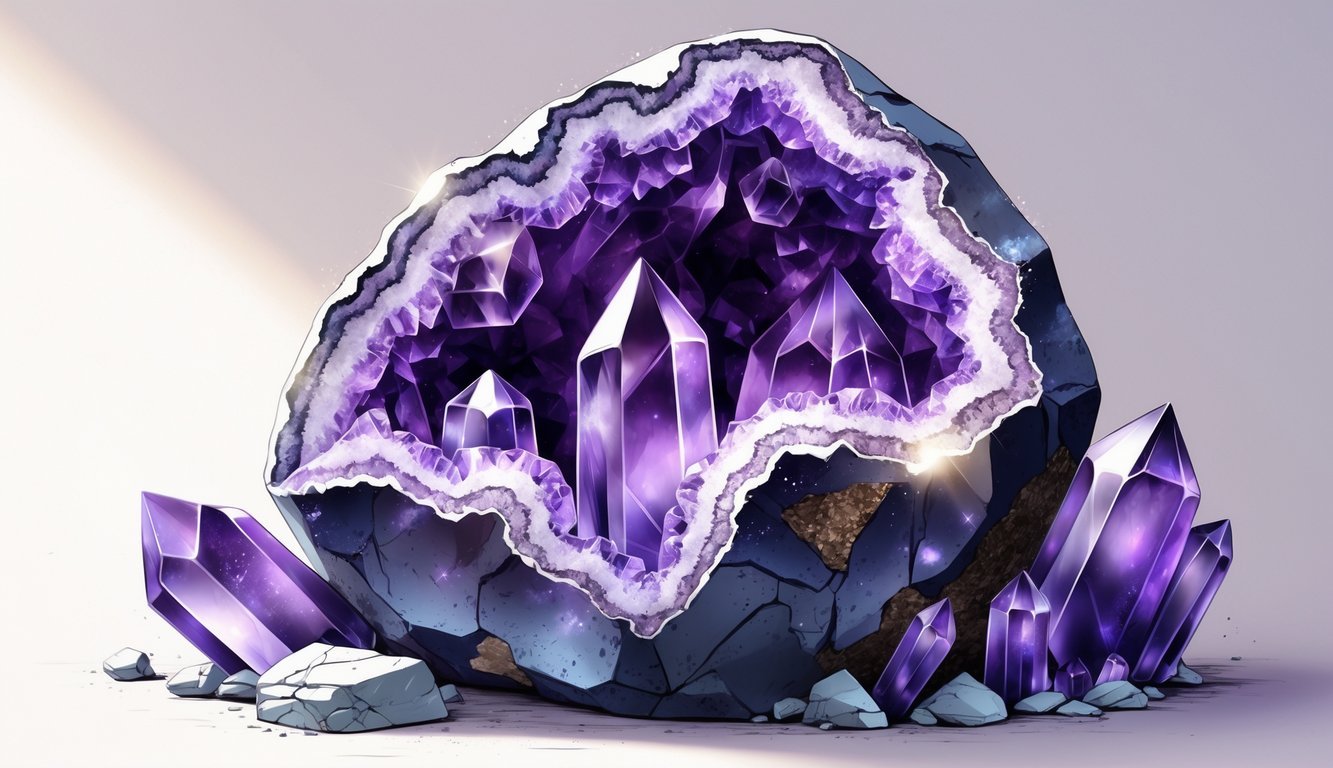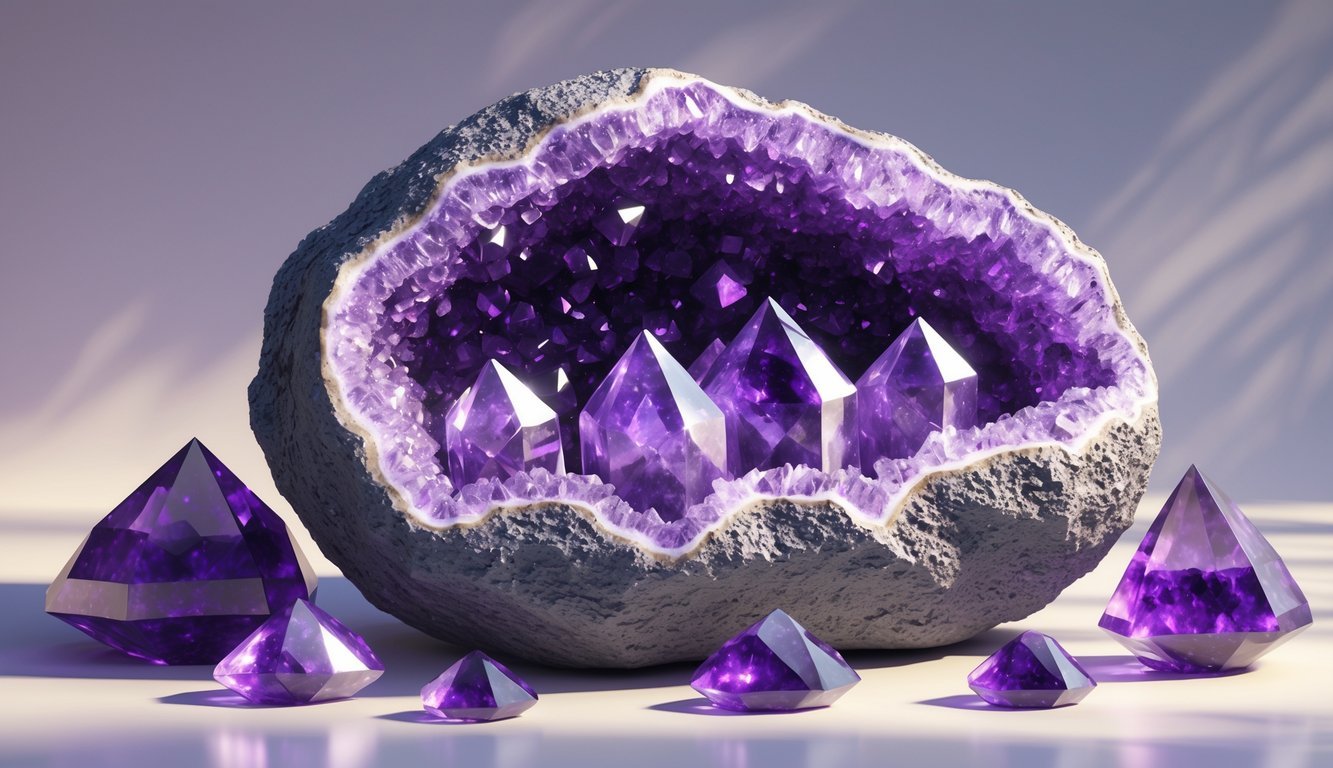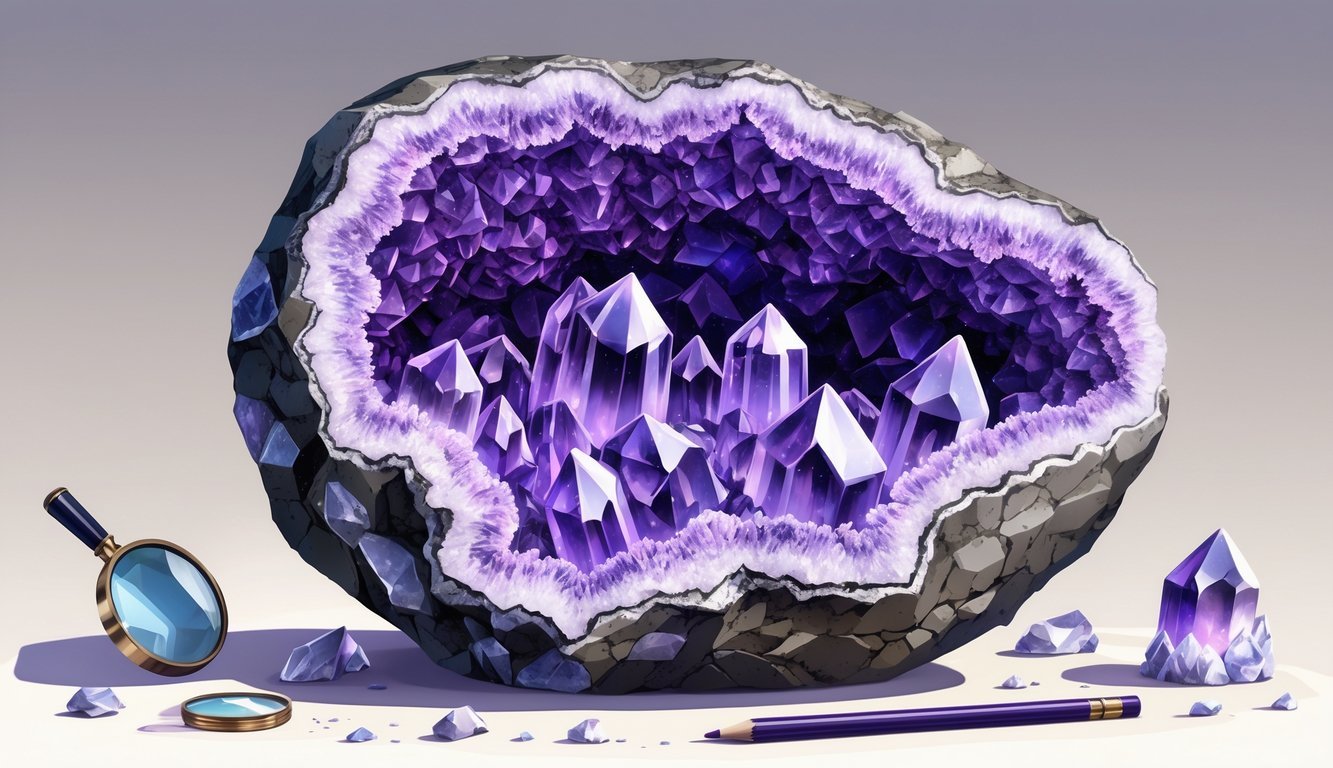PsychNewsDaily Publishers
100 Summit Drive
Burlington, MA, 01803
Telephone: (320) 349-2484
PsychNewsDaily Publishers
100 Summit Drive
Burlington, MA, 01803
Telephone: (320) 349-2484
Amethyst geodes are hollow rocks filled with purple quartz crystals, valued for their beauty, calming energy, and unique formations found globally, especially in Brazil and Uruguay.

Amethyst geodes are hollow rocks packed with gorgeous purple crystals that really draw your eye and bring a bit of the outdoors inside. These formations appear when minerals slowly grow crystals inside underground spaces, turning into natural works of art.
Amethyst geodes stand out for their rich color and crystal shapes, making them both beautiful and valuable.
You’ll come across all sorts of amethyst geodes, from tiny clusters to huge, cathedral-like pieces that really make a statement. People love these geodes for their beauty, calming vibes, and those unique, wild shapes.
If you know what to look for, you can pick geodes that fit your space or collection just right.
Maybe you want to decorate your home or you’re curious about crystal healing. Amethyst geodes bring something special to the table.
Their hollow, sparkling interiors make every geode different—a true piece of Earth’s art.

Amethyst geodes form naturally when crystals grow inside hollow rocks. They come to life through a slow process involving volcanic rocks, trapped gas bubbles, and minerals.
Their colors, shapes, and sizes can vary a lot, depending on where and how they formed. You’ll find geodes in different corners of the world, and their story goes way back—even ancient people admired them.
Amethyst geodes begin as gas bubbles in cooling volcanic lava. These bubbles create empty spaces, or cavities.
Over millions of years, water rich in minerals seeps into these spaces. The water brings silica, which slowly leaves behind quartz crystals.
Amethyst, a purple variety of quartz, forms thanks to a bit of iron and natural radiation. The crystals grow in clear hexagonal shapes, lining the inside walls.
This is a slow process—big crystals can take millions of years to form.
Most geodes have a round, bumpy outside but are hollow inside, with crystals pointing toward the center. You’ll usually spot them in volcanic rock, though they sometimes show up in sedimentary rock too.
Purple is the star color in amethyst geodes, ranging from pale violet to a deep, royal purple. The deeper the shade, the more valuable the crystal.
Some geodes might show hints of blue, green, or yellow if other minerals sneak in, but purple always steals the show.
Crystal clarity changes from one geode to the next. Some have clear, glassy surfaces, while others show tiny cracks or cloudy spots.
The crystals’ hexagonal shapes sparkle when light hits them just right.
The size of the crystals and the geode’s shape really matter for beauty. Large, deep purple crystals with few flaws are the most sought after.
Some geodes grow to impressive sizes, called amethyst cathedrals, and they never fail to wow.
You’ll find all sorts of amethyst geodes—tiny ones that fit in your hand and massive cathedrals that tower over a table.
The Empress of Uruguay is one of the biggest amethyst geodes out there, famous for its color and size.
Southern Brazil and Uruguay produce some of the finest, deepest purple geodes. You might also spot amethyst geodes from Mexico, the United States, or Germany.
Some geodes keep their natural backs instead of being filled with fake stuff, and collectors usually value those more.
Size, crystal depth, and shape all play a part in how much a geode is worth.
South America, especially Brazil and Uruguay, is where most amethyst geodes come from. Southern Brazil is known for its massive, richly colored geodes.
Uruguay’s Artigas region also produces some of the world’s best amethyst.
You’ll find geodes in other places like Mexico, the U.S., and Germany, but they often end up smaller or lighter in color.
Ancient Egyptians and Greeks treasured amethyst crystals. Scientists have studied how they form to learn more about volcanoes and minerals.
Today, people collect natural amethyst geodes for decoration and spiritual reasons.

Amethyst geodes can bring beauty and a sense of calm to your space. They’re also said to offer some physical and mental benefits.
If you know how to pick quality stones and take care of them, you’ll enjoy your geode even more.
When you’re shopping for an amethyst geode, go for a deep purple color that doesn’t look faded. Darker shades usually mean better quality.
Steer clear of stones with lots of cracks or chips—they’re just not as nice.
Check whether the geode has been treated with heat or irradiation; natural stones tend to be worth more.
You’ll sometimes see blue or green geodes, but purple is the classic. Size matters too—a big geode often costs more, but small ones can be easier to fit at home.
Buy from trusted sellers, and don’t be shy about asking where the stone came from. Some amethyst in jewelry or decor is dyed, so double-check if it’s natural.
People love amethyst geodes for their calming effects. Many say they help with stress, headaches, or even memory.
Plenty of folks use them during meditation to open the crown chakra or spark new ideas.
You might put a geode in your bedroom for better sleep, or set one in your living room to balance energy if you’re into feng shui.
Besides all that, they just look amazing—amethyst geodes can lift the vibe of any room.
Some people like to make amethyst-infused water, but always make sure the crystal is safe before trying that.
Keep your amethyst geode out of direct sunlight so the color won’t fade. Clean it gently with water and a soft brush if it gets dusty.
Skip harsh cleaners—they can damage the surface.
If you want to recharge your geode’s energy, try setting it under moonlight overnight or next to natural quartz clusters.
Little steps like these help keep your geode beautiful and full of good vibes.
Handle it gently to avoid cracks, since those can knock down the value and, some say, the energy too.
Enjoy the mix of natural art and good energy your amethyst geode brings to your life.

You can spot a quality amethyst geode by checking its color, banding, and how clear the crystals look. Size, color depth, and special mineral features like calcite all affect value.
Many people also care about the energy or calming effects these geodes bring.
Look for deep purple crystals with sharp points. Edges with cool agate banding make a geode stand out.
Try to avoid pieces with lots of damage or a dull color.
People often say amethyst helps with calmness and mental clarity. Some believe it boosts spiritual growth and balances a room’s energy.
Size, the richness of the purple color, and crystal shape all affect price. Extras like calcite or unusual patterns can bump the value up or down.
Absolutely—big geodes are out there at rock shops or online. You can even visit mines or gem shows if you want to see them in person.
Make sure the geode has plenty of crystal coverage inside. Avoid ones that are too small or cracked.
Sometimes you’ll find minerals like goethite inside, which can change the look a bit.
Natural geodes take thousands of years to form, and you can usually spot little irregularities in them. Lab-made amethyst, on the other hand, tends to look almost suspiciously perfect.
If you check out a natural geode, you’ll often see more interesting banding and color variation. Synthetic ones just don’t have that same variety or character.